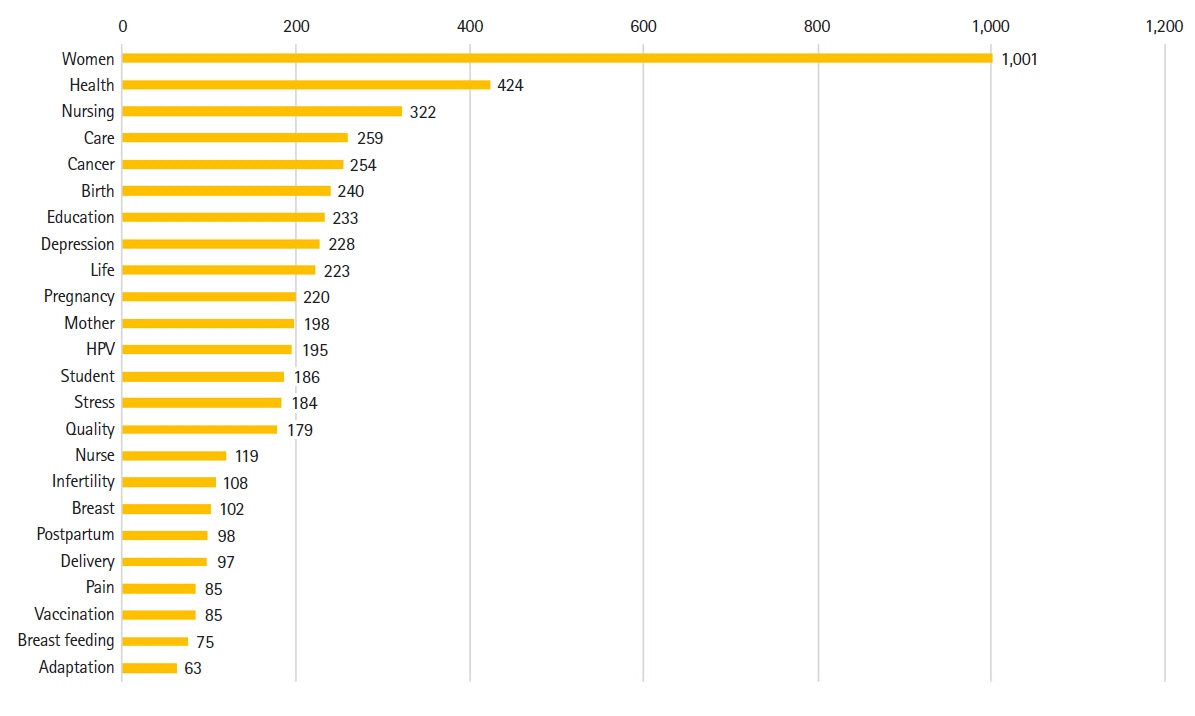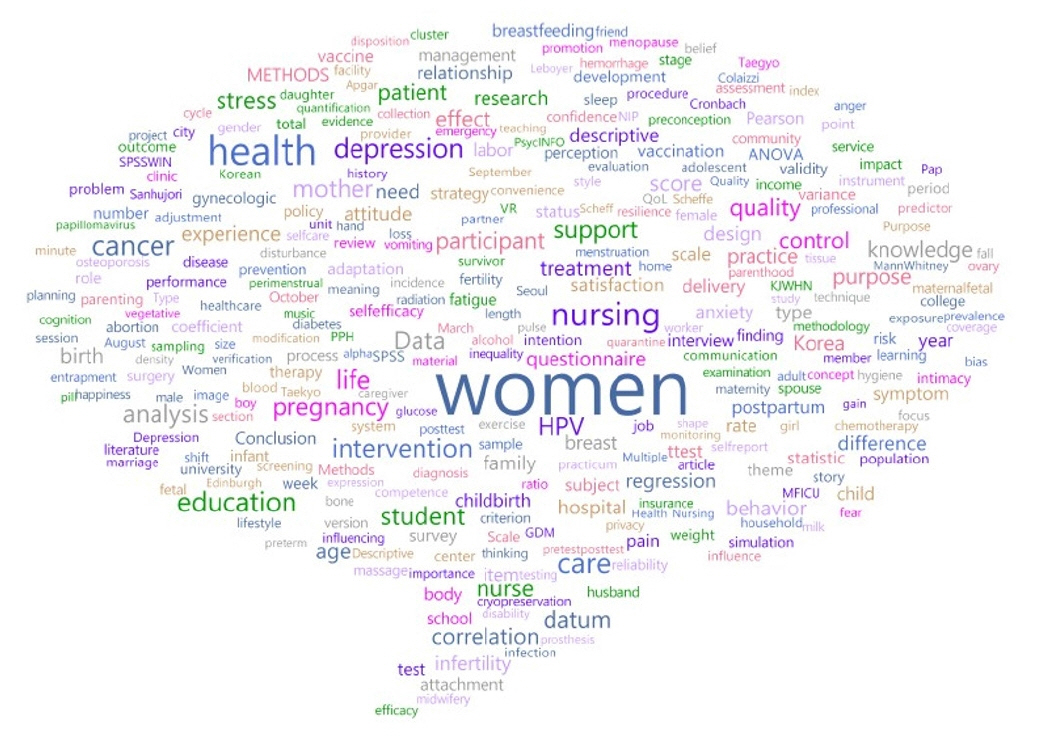Korean J Women Health Nurs.
2023 Jun;29(2):128-136. 10.4069/kjwhn.2023.06.20.1.
Research trends in the Korean Journal of Women Health Nursing from 2011 to 2021: a quantitative content analysis
- Affiliations
-
- 1College of Nursing, Jeonbuk National University, Jeonju, Korea
- KMID: 2543811
- DOI: http://doi.org/10.4069/kjwhn.2023.06.20.1
Abstract
- Purpose
Topic modeling is a text mining technique that extracts concepts from textual data and uncovers semantic structures and potential knowledge frameworks within context. This study aimed to identify major keywords and network structures for each major topic to discern research trends in women’s health nursing published in the Korean Journal of Women Health Nursing (KJWHN) using text network analysis and topic modeling.
Methods
The study targeted papers with English abstracts among 373 articles published in KJWHN from January 2011 to December 2021. Text network analysis and topic modeling were employed, and the analysis consisted of five steps: (1) data collection, (2) word extraction and refinement, (3) extraction of keywords and creation of networks, (4) network centrality analysis and key topic selection, and (5) topic modeling.
Results
Six major keywords, each corresponding to a topic, were extracted through topic modeling analysis: “gynecologic neoplasms,” “menopausal health,” “health behavior,” “infertility,” “women’s health in transition,” and “nursing education for women.”
Conclusion
The latent topics from the target studies primarily focused on the health of women across all age groups. Research related to women’s health is evolving with changing times and warrants further progress in the future. Future research on women’s health nursing should explore various topics that reflect changes in social trends, and research methods should be diversified accordingly.
Figure
Reference
-
References
1. Jun EM, Kang SW, Kang C. A trend analysis of Korean Journal of Women Health Nursing using by topic model. J Korean Data Anal Soc. 2021; 23(4):1855–1864. https://doi.org/10.37727/jkdas.2021.23.4.1855.
Article2. Yoon EK, Kim TW. Research trends and prospects of medical anthropology: concepts and their intersection with history of medicine. Korean J Med Hist. 2020; 29:903–958. https://doi.org/10.13081/kjmh.2020.29.903.
Article3. Ma L. Female labour force participation and second birth rates in South Korea. J Popul Res. 2016; 33(2):173–195. https://doi.org/10.1007/s12546-016-9166-z.
Article4. Lee SY, Hwang MJ. A trend analysis on non-married persons in accordance with educational attainment: comparison between Gangnam and Gangbuk in Seoul areas. J Soc Sci. 2014; 25(1):15–34. https://doi.org/10.16881/jss.2014.01.25.1.15.
Article5. Park JH, Bae SH, Jung YM. Validity and reliability of the Korean version of the Menopause-Specific Quality of Life. J Korean Acad Nurs. 2020; 50(3):487–500. https://doi.org/10.4040/jkan.20049.
Article6. Park JH, Chun M, Bae SH, Kim HJ. Research trends on factors influencing the quality of life of cancer survivors: text network analysis and topic modeling approach. Asian Oncol Nurs. 2021; 21(4):231–240. https://doi.org/10.5388/aon.2021.21.4.231.
Article7. Kim K, Lee KS. Identification of the knowledge structure of cancer survivors’ return to work and quality of life: a text network analysis. Int J Environ Res Public Health. 2020; 17(24):9368. http://doi.org/10.3390/ijerph17249368.
Article8. Lee SS. A content analysis of journal articles using the language network analysis methods. J Korean Soc Inf Manag. 2014; 31(4):49–68. http://doi.org/10.3743/kosim.2014.31.4.049.
Article9. Song M. Text mining. Seoul: Chungram Books;2017. 127 p.10. Baek YM. Text-mining using R. Paju (Korea): Hanul Academy Publishers;2017. 53 p.11. Lee DY, Noh GO. Research trends of middle-aged women’ health in Korea using topic modeling and text network analysis. J Converg Cult Techonol. 2022; 8(4):163–171. https://doi.org/10.17703/JCCT.2022.8.4.163.
Article12. Kim SM, Kim YJ. Research trend analysis on living lab using text mining. J Digit Converg. 2020; 18(8):37–48. https://doi.org/10.14400/JDC.2020.18.8.037.
Article13. Hwang SI, Shim JW. Semantic network analysis of “smart city” in newspaper articles: from 2016 to 2019. J Digit Contents Soc. 2020; 21(5):941–950. https://doi.org/10.9728/dcs.2020.21.5.941.
Article14. Kim JH, Mun HJ, Lee H. A study on trend analysis in convergence research applying word cloud in Korea. JDC. 2021; 19(2):33–38. https://doi.org/10.14400/JDC.2021.19.2.033.
Article15. Lee YJ, Kim SY, Kang SY, Kang YJ, Jin L, Jung HY, et al. Trend analysis of research articles published in the Korean Journal of Women Health Nursing from 2013 to 2017. Korean J Women Health Nurs. 2018; 24(1):90–103. https://doi.org/10.4069/kjwhn.2018.24.1.90.
Article16. Jeong YW, Kang KI, Lee BJ. A study on experiences of health problems and coping in middle-aged and elderly women in the community: focusing on focus group interview approach. J Korean Acad Community Health Nurs. 2020; 31(2):119–129. https://doi.org/10.12799/jkachn.2020.31.2.119.
Article17. National Cancer Information Center. Cancer incidence [Internet]. Goyang (Korea): Author;2020. [cited 2023 Jun 18]. Available from: https://www.cancer.go.kr/lay1/S1T639C640/contents.do.18. Chang HK. Influencing factors on health related quality of life in middle age. Korean J Adult Nurs. 2012; 24(4):330–347. https://doi.org/10.7475/kjan.2012.24.4.339.
Article19. Statistics Korea. 2022 Birth statistics (confirmation) [Internet]. Daejeon (Korea): Author;2022. [cited 2023 Apr 1]. Available from: http://kostat.go.kr/portal/korea/kor_nw/1/2/index.board?bmode=read&aSeq=362574.20. Jung YJ, Kim HY. Factors influencing infertility-related quality of life in women undergoing assisted reproductive techniques: focusing on depression and resilience. Korean J Women Health Nurs. 2017; 23(2):117–125. https://doi.org/10.4069/kjwhn.2017.23.2.117.
Article21. Kim M. National policies for infertility support and nursing strategies for patients affected by infertility in South Korea. Korean J Women Health Nurs. 2021; 27(1):1–5. https://doi.org/10.4069/kjwhn.2021.03.12.1.
Article22. Meleis AI, Sawyer LM, Im EO, Hilfinger Messias DK, Schumacher K. Experiencing transitions: an emerging middle-range theory. ANS Adv Nurs Sci. 2000; 23(1):12–28. doi: 10.1097/00012272-200009000-00006.
Article23. Chun N, Nho GO. Quality improvement of clinical practice in nursing students: focused on delivery room clinical practice. J Korea Contents Assoc. 2016; 16(7):513–521. http://doi.org/10.5392/JKCA.2016.16.07.513.
Article
- Full Text Links
- Actions
-
Cited
- CITED
-
- Close
- Share
- Similar articles
-
- Analysis of suicide statistics and trends between 2011 and 2021 among Korean women
- Identity of Women's Health Nursing
- Trends in Nursing Research on Sexuality in Korea
- Analysis of Research Trends on School Health
- Trend Analysis of Research Articles Published in the Korean Journal of Women Health Nursing from 2013 to 2017




